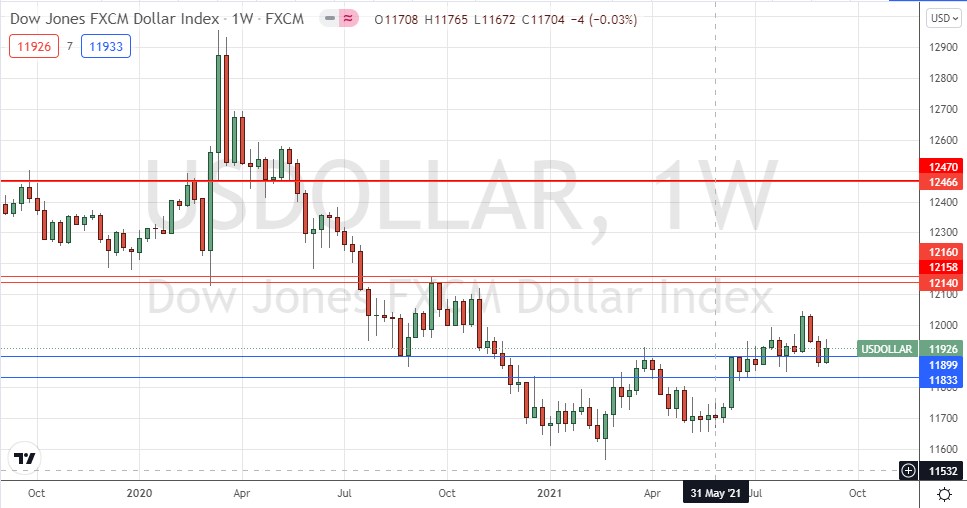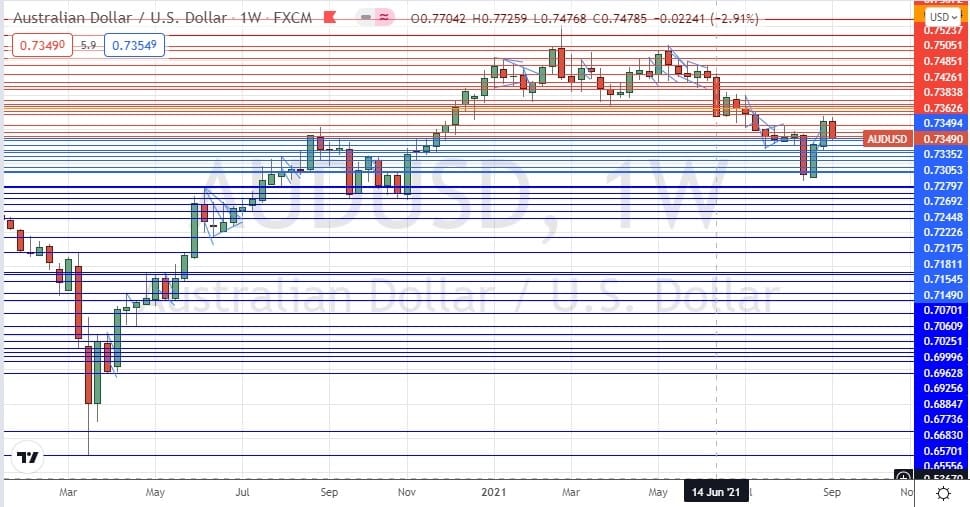The difference between success and failure in Forex trading is very likely to depend mostly upon which currency pairs you choose to trade each week and in which direction, and not on the exact trading methods you might use to determine trade entries and exits.
When starting the trading week, it is a good idea to look at the big picture of what is developing in the market as a whole and how such developments and affected by macro fundamentals and market sentiment.
There are a few strong valid long and short-term trends in the market right now, so it is a good time to be trading to take advantage of that.
Big Picture 12th September 2021
Last week’s Forex market mostly moved back in line with prevailing long-term trends, but overall, the price movement was relatively weak. Commodity currencies such as the AUD and the CAD fell while safe havens such as the USD and the JPY. Most global stock markets sold off during the week, with the notable exception of the Japanese market which saw a strong advance by the Nikkei 225 index.
I wrote in my previous piece last week that the best trade was likely to be long of the NASDAQ 100 and S&P 500 indices. The NASDAQ 100 Index produced a loss of 1.33%, while the S&P 500 Index fell by 1.63% last week, producing an averaged loss of 1.00%.
Fundamental Analysis & Market Sentiment
The headline takeaway from last week was a reduction in risk appetite that was manifested by falls in stocks and commodity currencies and rises in the USD and JPY. The risk-off sentiment has probably been driven mostly by fears that the US is not managing to really get a grip on the coronavirus and that the consequences of this threaten economic growth to some extent. The key economic events of last week were the monthly policy release from the European Central Bank and one from the Bank of Canada.
Next week will be dominated by data releases on CPI (inflation) from the US, UK, and Canada, plus US retail sales and New Zealand GDP.
Last week saw the global number of confirmed new coronavirus cases fall for the third consecutive week after rising for more than two months, with deaths also falling compared to the previous week for the first time in more than two months. Approximately 41.7% of the global population has now received at least one vaccination.
It seems to be becoming clear that due to the widespread Delta variant, which studies are beginning to show may be as easily transmissible as chickenpox, the only way to stop natural spread of the disease by “herd immunity” would be for more than 95% of an entire population to be fully vaccinated. There are also increasing indications that the effectiveness of vaccines wanes notably after approximately five months has elapsed from the last administration. These factors make even a local eradication of the coronavirus extremely difficult to achieve.
The strongest growth in new confirmed coronavirus cases right now is happening in Australia, Austria, Barbados, Belarus, Bosnia, Costa Rica, Croatia, Egypt, Latvia, Lithuania, Moldova, Philippines, Romania, Serbia, Singapore, Slovenia, and the UK.
Technical Analysis
U.S. Dollar Index
The weekly price chart below shows the U.S. Dollar Index printed a weakly bullish inside bar last week which rejected the zone of support which I have identified between 11899 and 11833. The price is still above the levels from 3 and 6 months ago, which shows that the long-term bullish trend in the greenback is still valid. However, there is little momentum, but on the other hand, the price has bounced from a zone which may provide significant support. This suggests that trades in the USD look somewhat better on the long rather than short side right now, so the best strategy in the Forex market over the coming week will probably be to look for long trades in US dollar currency pairs.
AUD/USD
The AUD/USD currency pair fell firmly last week, printing a bearish inside candlestick after rising over the previous couple of weeks. This currency pair is showing the highest medium-term volatility in the Forex market right now. This was a movement back in line with the long-term bearish trend. As market sentiment has turned risk-off and the AUD has become a key risk barometer currency, there could be a good short trade opportunity here over the coming week. Waiting for the end of Monday’s market and then trading breakdowns from Monday’s range short could be a good approach here.
Bottom Line
I see the best opportunity in the financial markets this week as likely to be in swing trades in the AUD/USD currency pair, probably on the short side.



